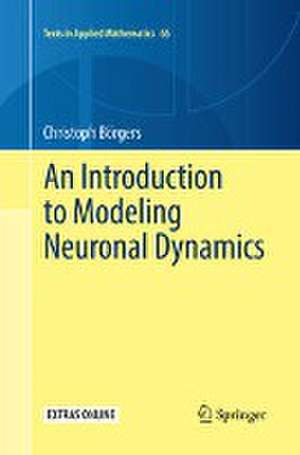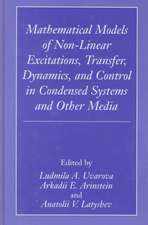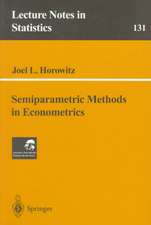An Introduction to Modeling Neuronal Dynamics: Texts in Applied Mathematics, cartea 66
Autor Christoph Börgersen Limba Engleză Paperback – 18 iul 2018
Topics include models of individual nerve cells and their dynamics, models of networks of neurons coupled by synapses and gap junctions, origins and functions of population rhythms in neuronal networks, and models of synaptic plasticity.
An extensive online collection of Matlab programs generating the figures accompanies the book.
| Toate formatele și edițiile | Preț | Express |
|---|---|---|
| Paperback (1) | 398.15 lei 6-8 săpt. | |
| Springer International Publishing – 18 iul 2018 | 398.15 lei 6-8 săpt. | |
| Hardback (1) | 458.71 lei 38-44 zile | |
| Springer International Publishing – 25 apr 2017 | 458.71 lei 38-44 zile |
Din seria Texts in Applied Mathematics
- 17%
 Preț: 368.61 lei
Preț: 368.61 lei - 17%
 Preț: 364.42 lei
Preț: 364.42 lei -
 Preț: 494.87 lei
Preț: 494.87 lei - 19%
 Preț: 505.89 lei
Preț: 505.89 lei - 17%
 Preț: 498.74 lei
Preț: 498.74 lei -
 Preț: 463.79 lei
Preț: 463.79 lei -
 Preț: 471.91 lei
Preț: 471.91 lei - 13%
 Preț: 427.17 lei
Preț: 427.17 lei -
 Preț: 447.93 lei
Preț: 447.93 lei - 8%
 Preț: 528.53 lei
Preț: 528.53 lei - 19%
 Preț: 586.76 lei
Preț: 586.76 lei - 15%
 Preț: 461.29 lei
Preț: 461.29 lei -
 Preț: 404.13 lei
Preț: 404.13 lei - 17%
 Preț: 364.52 lei
Preț: 364.52 lei - 17%
 Preț: 363.12 lei
Preț: 363.12 lei - 15%
 Preț: 594.73 lei
Preț: 594.73 lei -
 Preț: 492.20 lei
Preț: 492.20 lei - 15%
 Preț: 606.82 lei
Preț: 606.82 lei -
 Preț: 406.25 lei
Preț: 406.25 lei - 15%
 Preț: 534.60 lei
Preț: 534.60 lei - 18%
 Preț: 1233.03 lei
Preț: 1233.03 lei -
 Preț: 404.13 lei
Preț: 404.13 lei - 15%
 Preț: 662.27 lei
Preț: 662.27 lei - 15%
 Preț: 511.70 lei
Preț: 511.70 lei -
 Preț: 404.89 lei
Preț: 404.89 lei -
 Preț: 399.29 lei
Preț: 399.29 lei -
 Preț: 464.00 lei
Preț: 464.00 lei - 15%
 Preț: 535.34 lei
Preț: 535.34 lei - 15%
 Preț: 681.60 lei
Preț: 681.60 lei - 15%
 Preț: 732.81 lei
Preț: 732.81 lei -
 Preț: 394.87 lei
Preț: 394.87 lei
Preț: 398.15 lei
Nou
Puncte Express: 597
Preț estimativ în valută:
76.19€ • 83.02$ • 64.20£
76.19€ • 83.02$ • 64.20£
Carte tipărită la comandă
Livrare economică 23 aprilie-07 mai
Preluare comenzi: 021 569.72.76
Specificații
ISBN-13: 9783319845852
ISBN-10: 3319845853
Ilustrații: XIII, 457 p. 356 illus., 186 illus. in color.
Dimensiuni: 155 x 235 mm
Greutate: 0.65 kg
Ediția:Softcover reprint of the original 1st ed. 2017
Editura: Springer International Publishing
Colecția Springer
Seria Texts in Applied Mathematics
Locul publicării:Cham, Switzerland
ISBN-10: 3319845853
Ilustrații: XIII, 457 p. 356 illus., 186 illus. in color.
Dimensiuni: 155 x 235 mm
Greutate: 0.65 kg
Ediția:Softcover reprint of the original 1st ed. 2017
Editura: Springer International Publishing
Colecția Springer
Seria Texts in Applied Mathematics
Locul publicării:Cham, Switzerland
Cuprins
Vocabulary and Notation.- Modeling a Single Neuron.- The Nernst Equilibrium.- The Classical Hodgkin-Huxley ODEs.- Numerical Solution of the Hodgkin-Huxley ODEs.- Three Simple Models of Neurons in Rodent Brains.- The Classical Hodgkin-Huxley PDEs.- Linear Integrate-and-fire (LIF) Neurons.- Quadratic Integrate-and-fire (QIF) and Theta Neurons.- Spike Frequency Adaptation.- Dynamics of Single Neuron Models.- The Slow-fast Phase Plane.- Saddle-node Collisions.- Model Neurons of Bifurcation Type 1.- Hopf Bifurcations.- Model Neurons of Bifurcation Type 2.- Canard Explosions.- Model Neurons of Bifurcation Type 3.- Frequency-current Curves.- Bistability Resulting from Rebound Firing.- Bursting.- Modeling Nuronal Communication.- Chemical Synapses.- Gap Junctions.- A Wilson-Cowan Model of an Oscillatory E-I Network.- Entertainment, Synchronization, and Oscillations.- Entertainment by Excitatory Input Pulses.- Synchronization by Fast Recurrent Excitation.- Phase Response Curves (PRCs).- Synchronization of Two Pulse-coupled Oscillators.- Oscillators Coupled by Delayed Pulses.- Weakly Coupled Oscillators.- Approximate Synchronization by a Single Inhibitory Pulse.- The PING Model of Gamma Rhythms.- ING Rhythms.- Weak PING Rhythms.- Beta Rhythms.- Nested Gamma-theta Rhythms.- Functional Significance of Synchrony and Oscillations.- Rhythmic vs. Tonic Inhibition.- Rhythmic vs. Tonic Excitation.- Gamma Rhythms and Cell Assemblies.- Gamma Rhythms and Communication.- Synaptic Plasticity.- Short-term Depression and Facilitation.- Spike Timing-dependent Plasticity (STDP).- Appendices.- A. The Bisection Method.- Fixed Point Iteration.- Elementary Probability Theory.- Smooth Approximations of Non-smooth Functions.- Solutions to Selected Homework Problems.
Recenzii
“I would be happy to recommend this textbook to instructors seeking a textbook for an introductory course in mathematical neuroscience, and for students with quantitative backgrounds interested in taking such a course. … For those students beginning their climb from the established foundations of mathematical neuroscience towards these newer branches, An Introduction to Modeling Neuronal Dynamics offers a fine place to start.” (Braden A. W. Brinkman, SIAM Review, Vol. 61 (2), 2019)
“The book is supplemented with a helpful library of Matlab scripts that generate many of the plots and numerical results presented in it. The exercises encourage the readers to modify the scripts to create new plots ... the book takes the reader on a fascinating journey of neuronal dynamics via introduction, analysis and numerical simulation of relevant dynamical systems. It is written with clarity and rigor.” (Oksana Bihun, zbMATH 1382.92001, 2018)
Notă biografică
Christoph Börgers is Professor of Mathematics at Tufts University, USA. His expertise is in mathematical neuroscience, applied dynamical systems, numerical analysis, and scientific computing.
Textul de pe ultima copertă
This book is intended as a text for a one-semester course on Mathematical and Computational Neuroscience for upper-level undergraduate and beginning graduate students of mathematics, the natural sciences, engineering, or computer science. An undergraduate introduction to differential equations is more than enough mathematical background. Only a slim, high school-level background in physics is assumed, and none in biology.
Topics include models of individual nerve cells and their dynamics, models of networks of neurons coupled by synapses and gap junctions, origins and functions of population rhythms in neuronal networks, and models of synaptic plasticity.
An extensive online collection of Matlab programs generating the figures accompanies the book.
Topics include models of individual nerve cells and their dynamics, models of networks of neurons coupled by synapses and gap junctions, origins and functions of population rhythms in neuronal networks, and models of synaptic plasticity.
An extensive online collection of Matlab programs generating the figures accompanies the book.
Caracteristici
Includes access to Matlab codes generating the figures Exercises at widely varying levels are included at the end of every chapter Detailed writing allows for self-study opportunities Includes supplementary material: sn.pub/extras

























